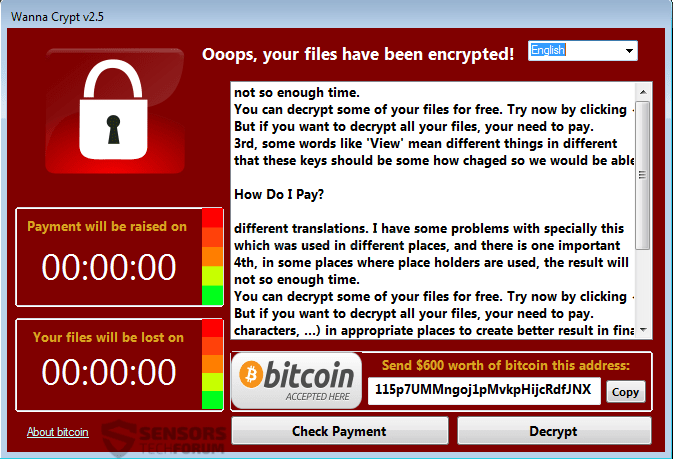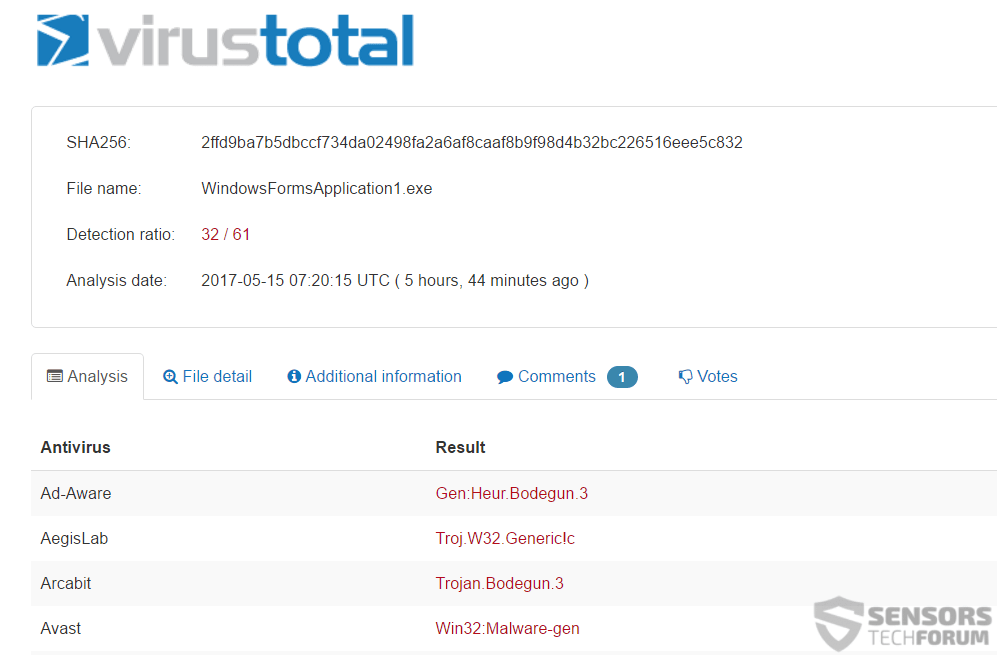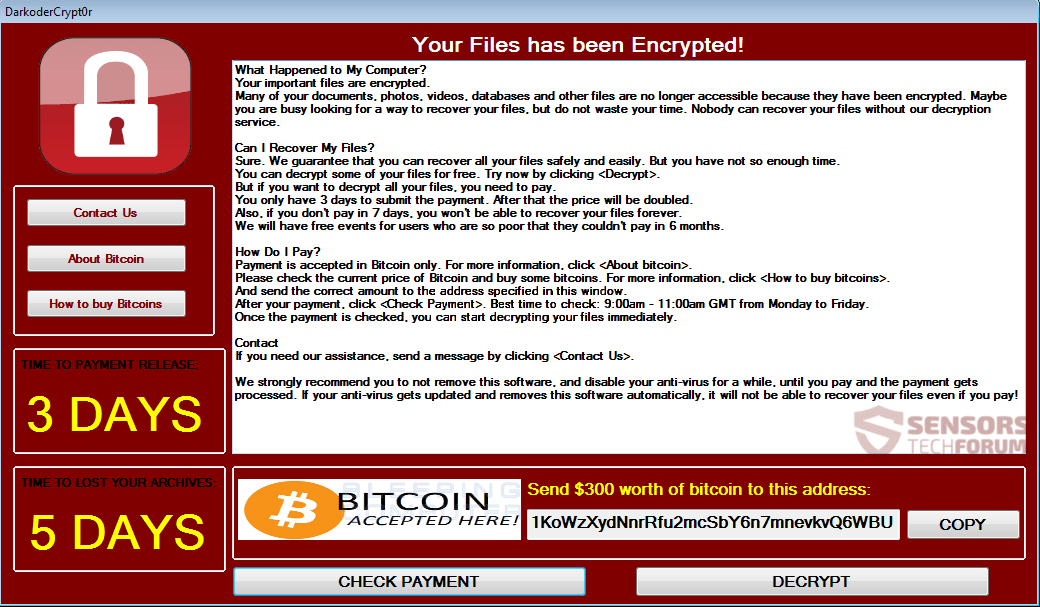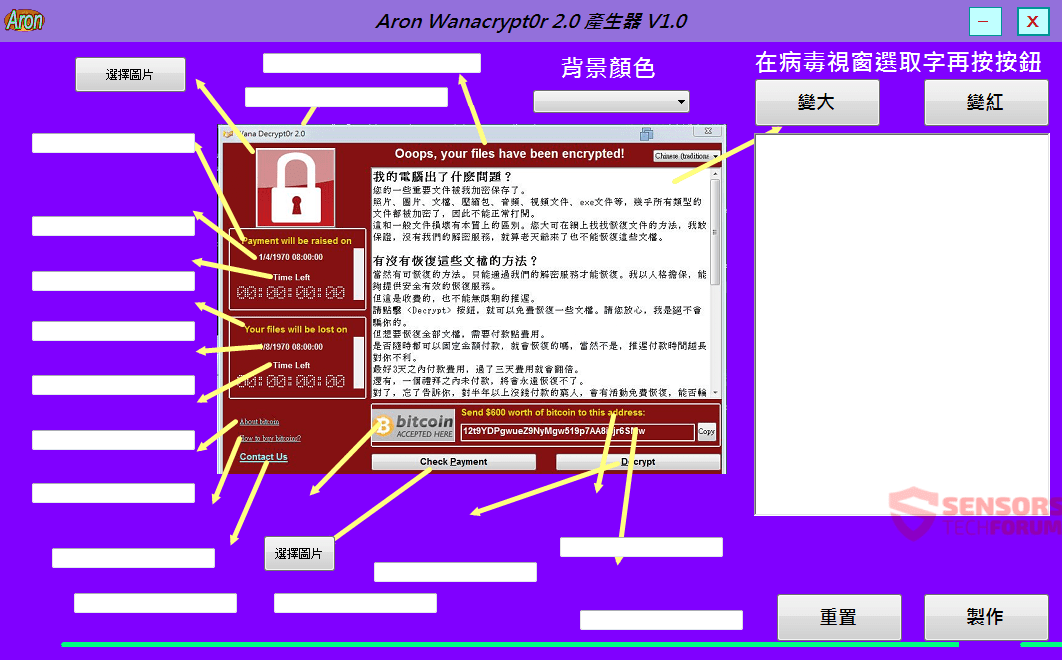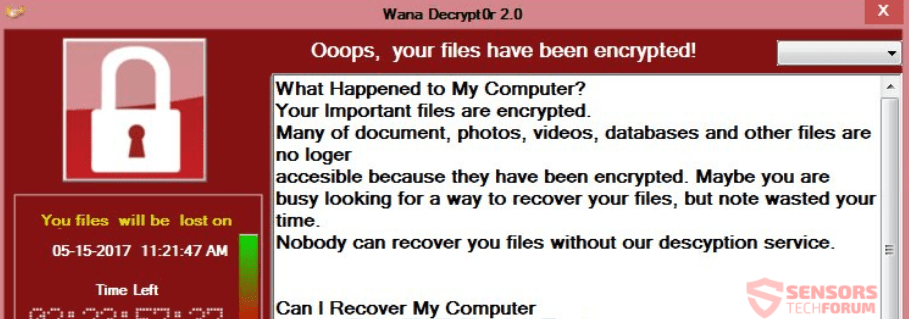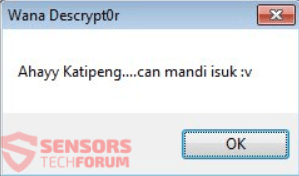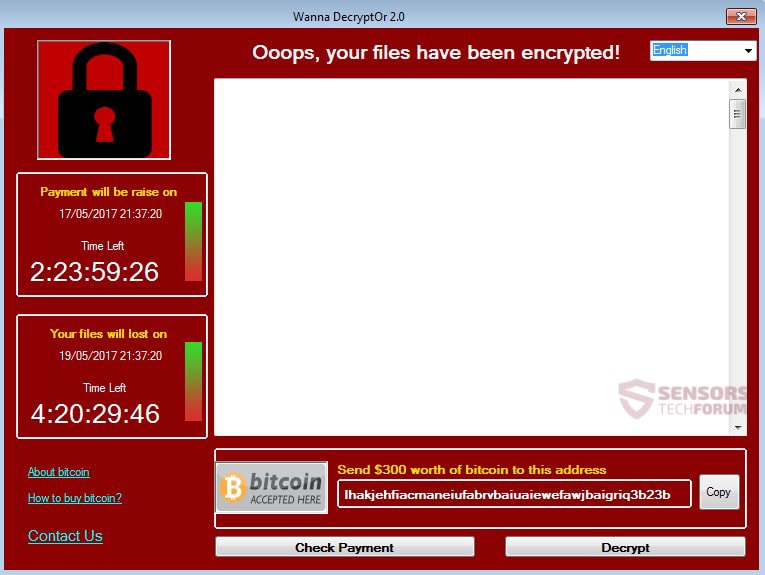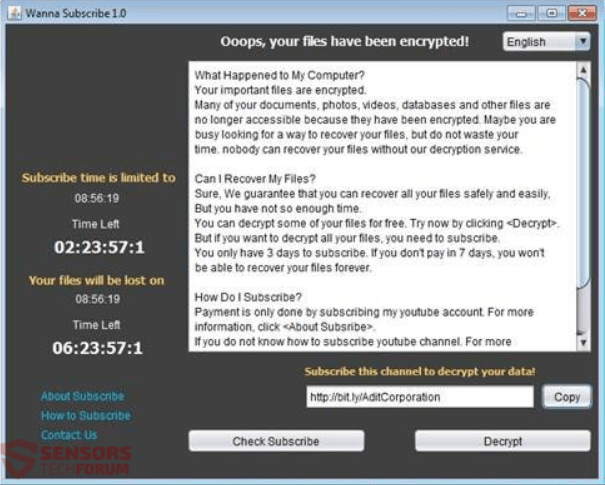WannaCry – a ransomware cryptovirus, that has infected computers over the globe across 150 countries, is already being looked up to by criminals. Successfully delivering the biggest ransomware attack in history, there is no wonder cybercriminals have started developing imitations of the WannaCry virus. In case you get infected by a clone of the malware, you should read the article and see how you could try to potentially recover some of your data.
WannaCry Ransomware Infection
WannaCry ransomware uses different methods to infect users’ PCs, and thus its imitations could use any number of ways to infect computer systems. Those ways however wouldn’t be much different. Using multiple malware e-mail spam campaigns might be the main way of distribution or using a worm to continue the infection from one machine to another over a network. These methods are used by WannaCry 2.0 right now and are viable for maintaining believable copycat version of it. However, impostors might utilize other ways for infecting.
As you can see above, one of the WannaCry ransomware copycats has a malicious executable that launches a script that infects a computer. Such files could be delivered even through social media and file-sharing networks. Often, files like these are advertised as freeware that is helpful, but instead might serve as the entry point for an infection. Refrain from opening files right after you have downloaded them, especially if they are from an unknown source. You should always first scan the files with a security tool. Read the ransomware prevention tips in our forum section to educate yourself on how to prevent ransomware attacks in general.
Below we will look at a few imitations of WannaCry that have surfaced and were discovered by malware researchers. As they are all still in-development, there is not much information to go on.

WannaCry Impostor #1 – DarkoderCrypt0r
DarkoderCrypt0r is still in its development phase, but probably the closest to being released, if you compare it to the other impostors. After encrypting files on your Desktop, it will display the following window:
As you can see it uses the same design and ransom note as the newest variant of the WannaCry virus aka Wana Decrypt0r 2.0.
All files are encrypted with the .DARKCRY extension and it gives you three days to pay the ransom sum of 300 US dollars. Its executable will be named @DaKryEncryptor@.exe, similarly to the original ransomware. Interestingly enough, this one uses the code of HiddenTear, so it would be decryptable, if it is released.

WannaCry Impostor #2 – Wanna Crypt v2.5
The Wanna Crypt v2.5 is also in-development, but sill behind, as it only shows the following lock-screen:
As you can see, the design is the same, with minor changes to the lock icon, timers etc. The ransom sum is 600 US dollars right from the beginning.
The ransom note of both variants described above is the following:
Ooops, your files have been encrypted!
What Happened to My Computer?
Your important files are encrypted.Many of your documents. photos, videos, databases and other files are no longer
accessible because they have been encrypted. Maybe you are busy looking for a way to
recover your files. but do not waste your time. Nobody can recover your files without
our decryption service.Can I Recover My Files?
Sure. We guarantee that you can recover all your files safely and easily. But you have 1
not so enough time.
You can decrypt some of your files for free. Try now by clicking
But if you want to decrypt all your files, you need to pay.
You only have 3 days to submit the payment. After that the price will be doubled.
Also, if you don’t pay in 7 days, you won’t be able to recover your files forever.
We will have free events for users who are so poor that they couldn’t pay in 6 months.How Do I Pay?
Payment is accepted in Bitcoin only. For more information, click
Please check the current price of Bitcoin and buy some bitcoins. For more information.
click
And send the correct amount to the address specified in this window.
After your payment, clickBest time to check: 9:00am – 11:00am
GMT from Monday to Friday.
Once the payment is checked, you can start decrypting your files immediately.Contact
If you need our assistance, send a message by clicking. We strongly recommend you to not remove this software, and disable your anti-virus for a while, until you pay and the payment gets processed. If your anti-virus gets updated and removes this software automatically, it will not be able to recover your files even if you pay!

WannaCry Impostor #3 – WannaCrypt 4.0
WannaCrypt 4.0 is also in its early stages of development and does not encrypt data at this time. However, while it copies the design of the ransom message window, it has an additional feature, as you can see below:
The whole ransom payment instructions text is written in the Thai language as it is probably made by and intended for the individual user of Thailand. That language is not supported by the original WannaCry.

WannaCry Impostor #4 – Aron WanaCrypt0r 2.0 Generator v1.0
Last, but definitely not least is the Aron WanaCrypt0r 2.0 Generator v1.0. The idea behind it is to make it into a generator of custom WannaCry versions, as seen right down here:
As seen above, there are multiple customizations that can be done, in terms of images, color and text, but only limited to the lock screen.

WannaCry Impostor #5 – Wana Decrypt0r 2.0 (Wana Descrypt0r)
A copycat variant called Wana Decrypt0r 2.0 and Wana Descrypt0r written in the Indonesian language is also being spread. The malware’s executable file is called MS17-010.exe referring to the Microsoft patch, which the original WannaCry virus used as an entry point exploit. Here is how it looks like:
Fortunately, it doesn’t encrypt files for now.

WannaCry Impostor #6 – @kee
@kee is an imitator which doesn’t care about your files. It will encrypt them and show the following message window:
The ransom note is also inside a file called “Hello There! Fellow @kee User!.txt“.
It states that there is no way for you to receive the key, and afterward it will delete your files.

WannaCry Impostor #7 – WannaDecryptOr 2.0
WannaDecryptOr 2.0 is an imitation of the WannaCry ransomware virus, which is still in-development and shows a blank page in its window as seen from the picture here:
Your files will not get encrypted, but they could be in the near future.

WannaCry Impostor #8 – Wanna Subscribe 1.0
Not much information is found about the Wanna Subscribe 1.0 impostor, other than that it is written in Java and has the following gray-colored design:
The following extensions which are encrypted by the current WannaCry variant, could also be placed for its clones to seek and lock:
→.der, .pfx, .key, .crt, .csr, .pem, .odt, .ott, .sxw, .stw, .uot, .max, .ods, .ots, .sxc, .stc, .dif, .slk, .odp, .otp, .sxd, .std, .uop, .odg, .otg, .sxm, .mml, .lay, .lay6, .asc, .sqlite3, .sqlitedb, .sql, .accdb, .mdb, .dbf, .odb, .frm, .myd, .myi, .ibd, .mdf, .ldf, .sln, .suo, .cpp, .pas, .asm, .cmd, .bat, .vbs, .dip, .dch, .sch, .brd, .jsp, .php, .asp, .java, .jar, .class, .wav, .swf, .fla, .wmv, .mpg, .vob, .mpeg, .asf, .avi, .mov, .mkv, .flv, .wma, .mid, .djvu, .svg, .psd, .nef, .tiff, .tif, .cgm, .raw, .gif, .png, .bmp, .jpg, .jpeg, .vcd, .iso, .backup, .zip, .rar, .tgz, .tar, .bak, .tbk, .PAQ, .ARC, .aes, .gpg, .vmx, .vmdk, .vdi, .sldm, .sldx, .sti, .sxi, .hwp, .snt, .onetoc2, .dwg, .pdf, .wks, .rtf, .csv, .txt, .vsdx, .vsd, .edb, .eml, .msg, .ost, .pst, .potm, .potx, .ppam, .ppsx, .ppsm, .pps, .pot, .pptm, .pptx, .ppt, .xltm, .xltx, .xlc, .xlm, .xlt, .xlw, .xlsb, .xlsm, .xlsx, .xls, .dotx, .dotm, .dot, .docm, .docb, .docx, .doc
The WannaCry copycats might also be set to erase the Shadow Volume Copies from the Windows operating system by implementing the usage of the following command:
→vssadmin.exe delete shadows /all /Quiet

Remove WannaCry Ransomware Impostors
If your computer got infected with some impostor of the WannaCry ransomware virus, you should have a bit of experience in removing malware. You should get rid of the ransomware as fast as possible before it can have the chance to spread further and infect other computers. You should remove the ransomware and follow the step-by-step instructions guide provided below.
- Step 1
- Step 2
- Step 3
- Step 4
- Step 5
Step 1: Scan for WannaCry Impostor with SpyHunter Anti-Malware Tool



Ransomware Automatic Removal - Video Guide
Step 2: Uninstall WannaCry Impostor and related malware from Windows
Here is a method in few easy steps that should be able to uninstall most programs. No matter if you are using Windows 10, 8, 7, Vista or XP, those steps will get the job done. Dragging the program or its folder to the recycle bin can be a very bad decision. If you do that, bits and pieces of the program are left behind, and that can lead to unstable work of your PC, errors with the file type associations and other unpleasant activities. The proper way to get a program off your computer is to Uninstall it. To do that:


 Follow the instructions above and you will successfully delete most unwanted and malicious programs.
Follow the instructions above and you will successfully delete most unwanted and malicious programs.
Step 3: Clean any registries, created by WannaCry Impostor on your computer.
The usually targeted registries of Windows machines are the following:
- HKEY_LOCAL_MACHINE\Software\Microsoft\Windows\CurrentVersion\Run
- HKEY_CURRENT_USER\Software\Microsoft\Windows\CurrentVersion\Run
- HKEY_LOCAL_MACHINE\Software\Microsoft\Windows\CurrentVersion\RunOnce
- HKEY_CURRENT_USER\Software\Microsoft\Windows\CurrentVersion\RunOnce
You can access them by opening the Windows registry editor and deleting any values, created by WannaCry Impostor there. This can happen by following the steps underneath:


 Tip: To find a virus-created value, you can right-click on it and click "Modify" to see which file it is set to run. If this is the virus file location, remove the value.
Tip: To find a virus-created value, you can right-click on it and click "Modify" to see which file it is set to run. If this is the virus file location, remove the value.
Before starting "Step 4", please boot back into Normal mode, in case you are currently in Safe Mode.
This will enable you to install and use SpyHunter 5 successfully.
Step 4: Boot Your PC In Safe Mode to isolate and remove WannaCry Impostor





Step 5: Try to Restore Files Encrypted by WannaCry Impostor.
Method 1: Use STOP Decrypter by Emsisoft.
Not all variants of this ransomware can be decrypted for free, but we have added the decryptor used by researchers that is often updated with the variants which become eventually decrypted. You can try and decrypt your files using the instructions below, but if they do not work, then unfortunately your variant of the ransomware virus is not decryptable.
Follow the instructions below to use the Emsisoft decrypter and decrypt your files for free. You can download the Emsisoft decryption tool linked here and then follow the steps provided below:
1 Right-click on the decrypter and click on Run as Administrator as shown below:

2. Agree with the license terms:

3. Click on "Add Folder" and then add the folders where you want files decrypted as shown underneath:

4. Click on "Decrypt" and wait for your files to be decoded.

Note: Credit for the decryptor goes to Emsisoft researchers who have made the breakthrough with this virus.
Method 2: Use data recovery software
Ransomware infections and WannaCry Impostor aim to encrypt your files using an encryption algorithm which may be very difficult to decrypt. This is why we have suggested a data recovery method that may help you go around direct decryption and try to restore your files. Bear in mind that this method may not be 100% effective but may also help you a little or a lot in different situations.
Simply click on the link and on the website menus on the top, choose Data Recovery - Data Recovery Wizard for Windows or Mac (depending on your OS), and then download and run the tool.
WannaCry Impostor-FAQ
What is WannaCry Impostor Ransomware?
WannaCry Impostor is a ransomware infection - the malicious software that enters your computer silently and blocks either access to the computer itself or encrypt your files.
Many ransomware viruses use sophisticated encryption algorithms to make your files inaccessible. The goal of ransomware infections is to demand that you pay a ransom payment to get access to your files back.
What Does WannaCry Impostor Ransomware Do?
Ransomware in general is a malicious software that is designed to block access to your computer or files until a ransom is paid.
Ransomware viruses can also damage your system, corrupt data and delete files, resulting in the permanent loss of important files.
How Does WannaCry Impostor Infect?
Via several ways.WannaCry Impostor Ransomware infects computers by being sent via phishing emails, containing virus attachment. This attachment is usually masked as an important document, like an invoice, bank document or even a plane ticket and it looks very convincing to users.
Another way you may become a victim of WannaCry Impostor is if you download a fake installer, crack or patch from a low reputation website or if you click on a virus link. Many users report getting a ransomware infection by downloading torrents.
How to Open .WannaCry Impostor files?
You can't without a decryptor. At this point, the .WannaCry Impostor files are encrypted. You can only open them once they are decrypted using a specific decryption key for the particular algorithm.
What to Do If a Decryptor Does Not Work?
Do not panic, and backup the files. If a decryptor did not decrypt your .WannaCry Impostor files successfully, then do not despair, because this virus is still new.
Can I Restore ".WannaCry Impostor" Files?
Yes, sometimes files can be restored. We have suggested several file recovery methods that could work if you want to restore .WannaCry Impostor files.
These methods are in no way 100% guaranteed that you will be able to get your files back. But if you have a backup, your chances of success are much greater.
How To Get Rid of WannaCry Impostor Virus?
The safest way and the most efficient one for the removal of this ransomware infection is the use a professional anti-malware program.
It will scan for and locate WannaCry Impostor ransomware and then remove it without causing any additional harm to your important .WannaCry Impostor files.
Can I Report Ransomware to Authorities?
In case your computer got infected with a ransomware infection, you can report it to the local Police departments. It can help authorities worldwide track and determine the perpetrators behind the virus that has infected your computer.
Below, we have prepared a list with government websites, where you can file a report in case you are a victim of a cybercrime:
Cyber-security authorities, responsible for handling ransomware attack reports in different regions all over the world:
Germany - Offizielles Portal der deutschen Polizei
United States - IC3 Internet Crime Complaint Centre
United Kingdom - Action Fraud Police
France - Ministère de l'Intérieur
Italy - Polizia Di Stato
Spain - Policía Nacional
Netherlands - Politie
Poland - Policja
Portugal - Polícia Judiciária
Greece - Cyber Crime Unit (Hellenic Police)
India - Mumbai Police - CyberCrime Investigation Cell
Australia - Australian High Tech Crime Center
Reports may be responded to in different timeframes, depending on your local authorities.
Can You Stop Ransomware from Encrypting Your Files?
Yes, you can prevent ransomware. The best way to do this is to ensure your computer system is updated with the latest security patches, use a reputable anti-malware program and firewall, backup your important files frequently, and avoid clicking on malicious links or downloading unknown files.
Can WannaCry Impostor Ransomware Steal Your Data?
Yes, in most cases ransomware will steal your information. It is a form of malware that steals data from a user's computer, encrypts it, and then demands a ransom in order to decrypt it.
In many cases, the malware authors or attackers will threaten to delete the data or publish it online unless the ransom is paid.
Can Ransomware Infect WiFi?
Yes, ransomware can infect WiFi networks, as malicious actors can use it to gain control of the network, steal confidential data, and lock out users. If a ransomware attack is successful, it could lead to a loss of service and/or data, and in some cases, financial losses.
Should I Pay Ransomware?
No, you should not pay ransomware extortionists. Paying them only encourages criminals and does not guarantee that the files or data will be restored. The better approach is to have a secure backup of important data and be vigilant about security in the first place.
What Happens If I Don't Pay Ransom?
If you don't pay the ransom, the hackers may still have access to your computer, data, or files and may continue to threaten to expose or delete them, or even use them to commit cybercrimes. In some cases, they may even continue to demand additional ransom payments.
Can a Ransomware Attack Be Detected?
Yes, ransomware can be detected. Anti-malware software and other advanced security tools can detect ransomware and alert the user when it is present on a machine.
It is important to stay up-to-date on the latest security measures and to keep security software updated to ensure ransomware can be detected and prevented.
Do Ransomware Criminals Get Caught?
Yes, ransomware criminals do get caught. Law enforcement agencies, such as the FBI, Interpol and others have been successful in tracking down and prosecuting ransomware criminals in the US and other countries. As ransomware threats continue to increase, so does the enforcement activity.
About the WannaCry Impostor Research
The content we publish on SensorsTechForum.com, this WannaCry Impostor how-to removal guide included, is the outcome of extensive research, hard work and our team’s devotion to help you remove the specific malware and restore your encrypted files.
How did we conduct the research on this ransomware?
Our research is based on an independent investigation. We are in contact with independent security researchers, and as such, we receive daily updates on the latest malware and ransomware definitions.
Furthermore, the research behind the WannaCry Impostor ransomware threat is backed with VirusTotal and the NoMoreRansom project.
To better understand the ransomware threat, please refer to the following articles which provide knowledgeable details.
As a site that has been dedicated to providing free removal instructions for ransomware and malware since 2014, SensorsTechForum’s recommendation is to only pay attention to trustworthy sources.
How to recognize trustworthy sources:
- Always check "About Us" web page.
- Profile of the content creator.
- Make sure that real people are behind the site and not fake names and profiles.
- Verify Facebook, LinkedIn and Twitter personal profiles.


